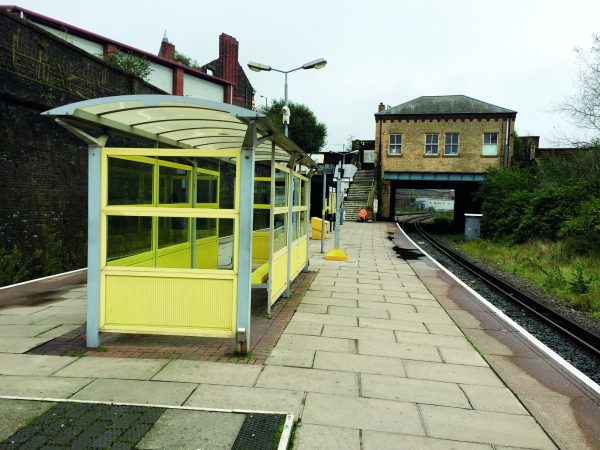Merseyrail give Energy Vault the green light
- May 18, 2018
- Blog



Pictured above is Bank Hall Street Station where the Energy Vault is being tested.
In a continuously innovating modern world in which technology advancements seem to have no boundaries, rail stations are now facing increasing pressure to deliver on expected energy requirements and carbon footprint reduction.
A recent announcement of the 25-year plan to protect the environment has indeed triggered our awareness for the desperation of ‘A cleaner greener Britain’: the next ambitious milestone to de-carbonise the UK. Yes, the country has been a world leader in cutting emissions so far and strives to reduce emissions further, but we will fall short of our ambitions unless solid plans are put into place and soon.
The Climate Change Levy (CCL) is a tax that adds around 15% to the energy bills of all businesses, with the aim to reduce carbon footprint and increase energy efficiency. Some businesses can negotiate discounts with the likes of Climate Change Agreements (CCA) – a voluntary agreement between the Environment Agency and UK industries. On behalf of the country, the scheme aims to reduce CO2 emissions and improve energy efficiency.
With that said, the country could still miss set targets for 2020; it is evident that more needs to be done. Some companies are realising that not only do they need to meet expected targets, but they can in fact make a considerable difference by taking actions into their own hands to contribute towards the Clean Growth Strategy.
It is safe to say that low voltage devices have been emerging into modern rail stations gradually over the years with the introduction of IP (Internet Protocol) devices. Low wattage consumption for IP CCTV and all business necessities for UK rail stations are now being designed and implemented across the country. Emergence of these IP and PoE (Power over Ethernet) devices has very much challenged the traditional cabling architecture; not forgetting the focus on renewable energy solutions and carbon footprint reduction too.
Merseyrail have been testing QED’s Energy Vault (EV) for a considerable amount of time now at Bank Hall Street station. Network Rail standards state that a UPS system must be capable of supporting the entire system for a minimum of 1 hour. The problem is that the rack providing SISS equipment provides only 1-hour autonomy and therefore, any PoE devices will shut down.

The Energy Vault battery storage system is not only in the process of obtaining PADS approval from Network Rail but also provides autonomy that exceeds the basic standards; stretching above and beyond expectations. QED’s own tests have proven that the EV can run 96 cameras whilst providing autonomy of the rack and cameras for 19 hours. Additional benefits that the Energy Vault provides are carbon efficiency and the capability to distribute electricity off-grid throughout the day, eliminating the requirement for a UPS back-up system. The EV’s ability to reduce CO2 emissions stems from the efficient elimination of AC-DC conversion. Due to the device being based on a DC infrastructure, it is not required to convert, meaning it can plug directly into renewable energy sources without losing any power.
Paul Collins, Asset Project Manager at Merseyrail stated: “The EV has performed better than anticipated. We operated the load off-grid all day and night to then charge it back to 100% capacity between midnight and 1:30am. It was consistently reliable and supplied continuous electricity to our cameras, NVR, and Network Switch. In the near future, we are looking to implement the device into larger stations with renewable sources.”
QED monitored the system from 5th-22nd January 2018 to demonstrate the Energy Vault’s performance. Whilst running the station cameras, NVRs and switches from the device, the unit operated beyond expectations due to low load demand. The 1.2kw system only required 500 watts for 1.5 hours of recharging time.

Chart showing the load and usage of the Energy Vault in blue (approximately 25-30w of usage). The charging periods are displayed in orange.
Not only does the Energy Vault reduce carbon footprint and allow you to operate off grid, it can ensure the continuous operation of SISS and other low voltage devices which are a necessity for the day to day running of a modern railway station. As mentioned previously, there is an increasing pressure for the department of transport to deliver on expected energy requirements and carbon reduction. As more and more people become aware of the need for ‘a cleaner, greener Britain’, more and more people are taking matters into their own hands and doing their part to contribute towards the future of the proposed Clean Growth Strategy.
Could Energy Vault be the missing link between renewable energy sources and all up and coming new low voltage technologies?
Share the article
Call us: 01772 336 111
Email us: sales@qedgroup.co.uk
Address:
445 Oakshott Place
Walton Summit Centre
Bamber Bridge
Preston. PR5 8AT
Sign up for special offers and news
Call: 01772 336 111
Email: sales@qedgroup.co.uk
Address:
445 Oakshott Place
Walton Summit Centre
Bamber Bridge
Preston. PR5 8AT
This website uses cookies so that we can provide you with the best user experience possible. Cookie information is stored in your browser and performs functions such as recognising you when you return to our website and helping our team to understand which sections of the website you find most interesting and useful.
Strictly Necessary Cookie are enabled at all times so that we can save your preferences for cookie settings.
This website uses Google Analytics to collect anonymous information such as the number of visitors to the site, and the most popular pages.
Keeping this cookie enabled helps us to improve our website.
Please enable Strictly Necessary Cookies first so that we can save your preferences!
More information about our Cookie Policy